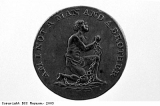Slave rebellions on plantations
Slave uprisings, or rebellions and revolts, were frequent and were ferociously put down by plantation owners. The idea was to put off future rebels by showing them how any rebellion would be punished. Participants of rebellions were often publicly killed ‘by progressive mutilation, slow burnings, breaking on the wheel.’ The wheel was a form of torture where bones were dislocated and the body pulled apart on a wheel. Slaves were also ‘tortured or starved to death in cages.’ On the Caribbean island of Antigua, 77 slaves, or ‘rebels’ as they were described, were burned alive in 1736. 400 were executed for joining Tacky, a slave who led a rebellion in Jamaica in 1760. As late as 1832, the rebellion known as the ‘Baptist War’ or Emancipation Rebellion (1831-2) on the island of Jamaica resulted in the killing of 200 slaves in battle and the execution of 344 more.
The first major slave rebellion was in 1522. The slaves on the Spanish island of Hispaniola (now the Dominican Republic and Haiti) tried to escape. Revolts were a regular feature of the plantations after that. Before the end of the 17th century, there had been rebellions on the islands of St Kitts, Barbados, Guadeloupe and Jamaica. Slave rebellions continued into the 18th century, and intensified in the early 19th century as the slaves heard rumours about the approaching end of slavery.
The French Revolution (in 1789) inspired revolutionary ideas about freedom. Such ideas in turn sparked a slave rebellion in the French-owned Caribbean island of Haiti in the same year. Following this, Haiti became the first independent black state. The new French government did away with slavery throughout the French-owned colonies in 1794. But by 1800 French politics had changed again, and the leader Napoleon sent troops to the Caribbean to re-establish slavery. On the island of Haiti, the leader of the slave rebellion there, Toussaint l’Ouverture was captured and taken to France. He died in prison there, but the slaves on Haiti resisted the French and British attempts to win back the island, and Haiti remained the first independent black state.
There were many more slave rebellions before slavery ended (which was in 1834 in Britain, 1865 in the USA, 1869 in Portugal, 1888 in Brazil, 1942 in Ethiopia). Abolition of the slave trade and the freeing of slaves is often thought of as the result of a change in European thought, seeing slavery as cruel and inhumane. The ‘logo’ of the Abolition movement, which campaigned against slavery, was an image of a kneeling slave asking for help. It is pictured here on an Abolition penny token. Both the image and the slogan ‘Am I not a man and a brother’ were widely used to raise awareness and show support for the campaign to end slavery. The passive role of the African slave shown here fails to show the truth of the fight against slavery. Slaves themselves had long been active in resistance to slavery.
Few people realise that the slaves themselves fought for their freedom and in fighting helped to win it. In Britain, the trade in slaves was ended in 1807, by a law for the Abolition of the Slave Trade. In 1833, slavery itself was abolished by law. These two changes were brought about by a combination of events. Activists campaigned for the slave trade and then slavery to end and influenced public and political opinion. Combined with the continual resistance of the slaves themselves, and the change in opinion back home about the slave trade, abolition and emancipation eventually came. Often, the role of the campaigners in Britain is seen as the only reason for the end of the slave trade and slavery. In reality, the problems caused by the slaves themselves were a severe threat to the continuation of slavery and the economic viability of the plantation system.
For more about this debate, see the section Against Slavery.



